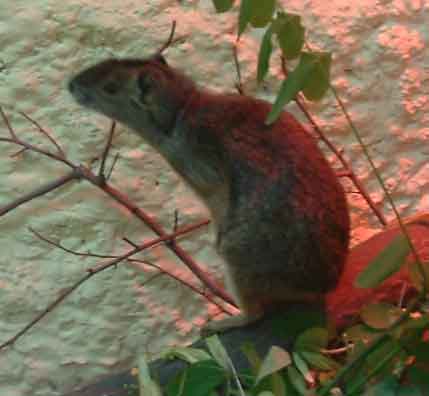Kerodon rupestris (*) Cladus: Eukaryota Name Kerodon rupestris (Wied-Neuwied, 1820) References * Kerodon rupestris on Mammal Species of the World.
The rock cavy or mocó, Kerodon rupestris, is a cavy species endemic to eastern Brazil, from eastern Piauí state to Minas Gerais state. It has been introduced to the oceanic island of Fernando de Noronha.[2] Rock cavies are found in dry rocky areas, with low scrubby vegetation, and close to stony mountains and hills, resembling another (only distantly related) creature, the Rock Hyrax. They usually shelter in crevices and are territorial animals, defending rock piles against other adult males. The rock cavy is a fairly large rodent weighing up to 1 kilogram (2.2 lb) and, as in other cavies, the tail is vestigial or absent. The dorsum is grey and the venter light brown. They feed on seed and leaves of the scrubby vegetation that grows in their territory. They live in groups and give birth to one or two young only, but several litters per year are common. The gestation period averages seventy-five days. They can, sometimes, display homosexual behavior with adult males courting juvenile males. Each group has an alpha or dominant male and several females. Rock cavies are common animals, even though they are frequently hunted for food by local human populations. References ^ Catzeflis, F., Patton, J., Percequillo, A., Bonvicino, C. & Weksler, M. (2008). Kerodon rupestris. In: IUCN 2008. IUCN Red List of Threatened Species. Downloaded on 5 January 2009. John F. Eisenberg and Kent H. Redford, 2000. Mammals of Neotropics: Ecuador, Bolivia and Brazil. Source: Wikipedia, Wikispecies: All text is available under the terms of the GNU Free Documentation License |
|


